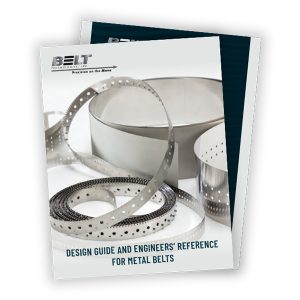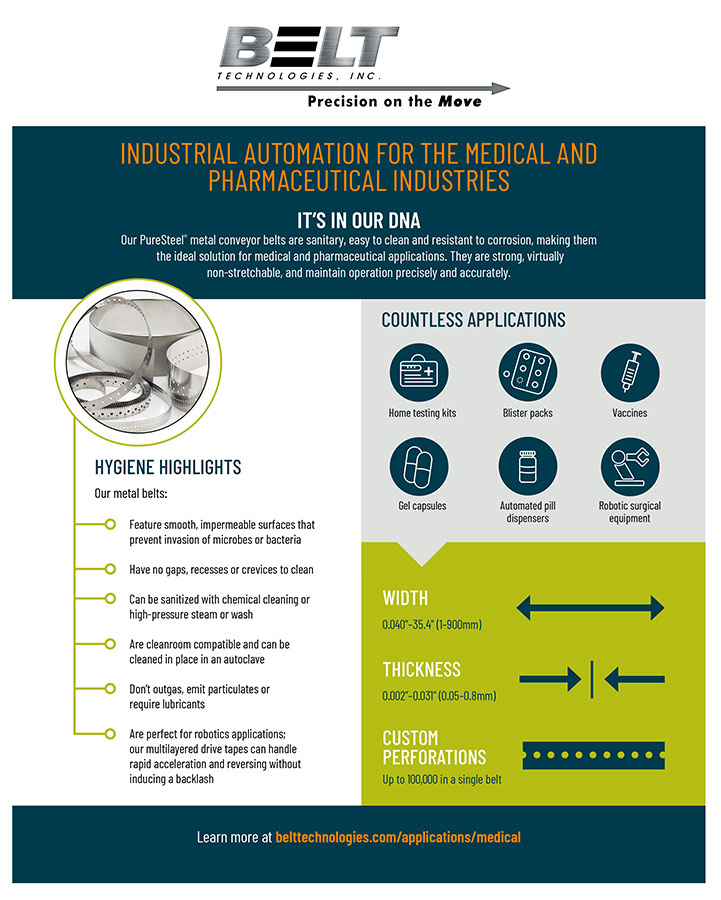A customer recently came to Belt Technologies for help with an automated system. The system used a timing belt with specific, built-in compartments to transport vials of medical biopsies. The timing belt carried the vials to a refrigerated storage system. Because the samples needed to be kept at low temperatures to remain usable, the original belt material lasted a very limited number of cycles and required frequent replacement and maintenance.
When designing timing belts for applications involving extreme temperatures, the specific properties of the belt material must be considered to achieve optimal performance. Belt Technologies can help you choose the right material for your timing belt with expert advice based on years of experience dealing with challenging high and low temperature automation applications requiring precise timing.
Overcome the Challenges of Intense Hot and Cold Operating Conditions with the Unique Properties of Stainless Steel
Extreme temperatures can shorten the lifespan of your automated equipment, causing damage that results in frequent and costly adjustment, replacement, and repair. Inferior materials such as plastic, rubber, or cloth will warp, burn, or fall apart when exposed to high temperatures. In extremely cold temperatures, belt materials will shrink or become brittle, leading to the eventual failure of the belt. Choosing a material that is able to withstand the continuous stress of an extreme temperature environment will help maintain operational efficiency by preventing unnecessary damage.
Stainless steel has many beneficial properties for automated manufacturing. One of these benefits is its low thermal coefficient of expansion, which enables stainless steel alloys to resist a wide range of temperature extremes without warping or breaking. Our engineers can help you choose the specific grade of stainless steel that will be the most effective for your application. For extremely elevated temperatures, our engineers typically recommend Inconel, which has the ability to resist temperatures as high as 1,600°F. Other options include Invar, which will resist distortion in temperatures up to 400°F.
Timing belts require additional consideration during the design phase to compensate for the material effects of extreme temperatures and ensure accurate indexing and positioning is preserved. Our engineers can ensure your timing belt will maintain proper tensioning and product position, even in conditions where the temperature may cause the belt material to shrink or expand.
Expert Material and Design Advice from Experienced Engineers
Belt Technologies has experience with engineering challenges that deal with precise timing applications operating within extreme temperature environments, such as:
- Indexed cooking/freezing applications
- Semiconductor production
- Cleanroom environments and vacuum chambers
- Cooking ovens for food processing
- Annealing ovens for glass, such as those used to produce light bulbs
- CNC cutting tables (plasma, laser, water jet, etc.)
For the medical manufacturer seeking a more temperature-resistant timing belt for their medical biopsy transportation system, ensuring the accuracy of the belt was the main priority. The medical biopsies would be transported long distances and the belt needed to return precisely to its starting position. The expert team at Belt Technologies recommended replacing the belt with a standard 300-series stainless steel timing belt. Our engineers were able to provide the client with a 300-series stainless steel timing belt with accurate tensioning for the temperature conditions of the customer’s automated system so that the belt positioning would remain precise and constant.
Belt Technologies can provide expert design and engineering advice for timing belt applications involving extreme temperatures. With advanced material expertise and experience, our engineers can help you choose the right grade of stainless steel to ensure your automated system will continue to function smoothly and efficiently. For more information about stainless steel timing belts for high or low temperature applications, contact Belt Technologies today.



